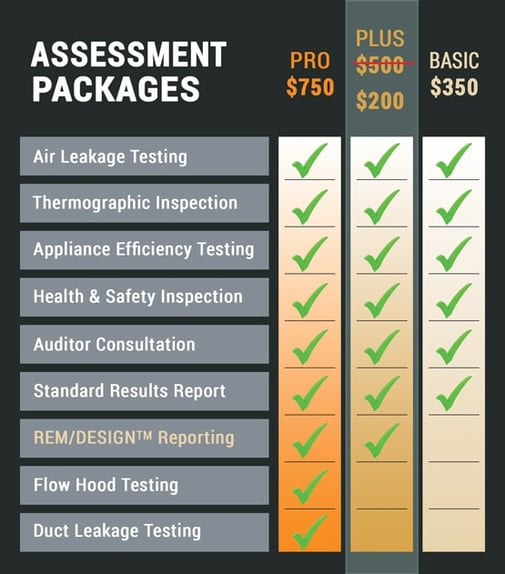Is your HVAC system working too hard? Use energy testing to find out
Is your HVAC system working too hard? Use energy testing to find out
Blog Article
The Function of Energy Testing in Attaining an Airtight Service for Your Residential property
Power screening is vital for homeowner seeking to produce an impermeable atmosphere. It recognizes air leakages and ineffectiveness that can endanger energy efficiency. Common wrongdoers include voids around doors and windows. Using approaches like blower door tests and thermal imaging, home owners can acquire understandings into their property's vulnerabilities (energy testing). Comprehending these searchings for is crucial. What steps should be taken once air leaks are recognized? The responses hold the trick to boosted comfort and cost savings
Recognizing Energy Testing and Its Relevance
Energy screening plays a necessary role in examining the airtightness of structures and frameworks. By gauging air leak, this method supplies crucial understandings right into a residential property's power performance, thermal comfort, and overall performance. Airtight buildings lower energy consumption, making sure that home heating and air conditioning systems run effectively. This testing process normally entails methods such as blower door tests, which produce a controlled environment to identify unintentional air pathways.Understanding the relevance of power testing prolongs beyond conformity with building ordinance; it cultivates a proactive approach to sustainability. Identifying air leakages early can bring about timely remediation, ultimately enhancing interior air top quality and decreasing utility prices. In addition, power screening adds to the durability of building materials by minimizing wetness build-up and related damages. As understanding of ecological influence boosts, energy screening ends up being a crucial tool for property owners and home builders aiming for high-performance residential properties.
Typical Resources of Air Leaks in Characteristic
Recognizing common resources of air leakages is crucial for improving a property's energy efficiency. These leaks commonly occur in numerous areas of a structure, substantially impacting heating & cooling expenses. Typical culprits consist of gaps around doors and windows, where seals might weaken with time. Additionally, electric outlets and buttons can produce paths for air exchange if not appropriately shielded. Cellars and attics are likewise constant sources, specifically where wall surfaces fulfill the foundation or the roofing. Various other potential leakage points consist of pipes infiltrations, venting systems, and the areas bordering smokeshafts. Older homes may experience from weakened structure materials, enhancing vulnerability to air infiltration. By acknowledging these common resources, residential or commercial property owners can take positive actions to seal leaks, thus improving general energy effectiveness and convenience within their areas. Resolving these concerns is an important part of establishing an airtight solution for any residential property.
Approaches of Power Screening: Blower Door and Thermal Imaging
Efficient power screening approaches, such as blower door examinations and thermal imaging, play a crucial duty in identifying air leakages within a building. The blower door examination includes depressurizing a structure or pressurizing to gauge air flow and identify leakages. An adjusted fan is mounted in an outside entrance, and the resulting stress difference highlights locations of unwanted air seepage. This method evaluates the general airtightness of the structure.Thermal imaging matches blower door examinations by aesthetically spotting temperature variants on surfaces, exposing surprise air leaks. Infrared video cameras record warm loss or gain, enabling specific recognition of problem locations, such as badly protected walls or voids around doors and windows. air tight solutions. Together, these techniques supply an extensive evaluation of a residential property's energy effectiveness, enabling residential property owners to resolve air leaks successfully and improve total efficiency
Benefits of Identifying Air Leaks
Identifying air leakages offers substantial advantages for energy performance and indoor convenience. By sealing these leakages, structures can decrease power consumption, bring about lower utility expenses and a minimized carbon impact. Additionally, enhanced airtightness adds to a much more stable indoor setting, improving total convenience for owners.
Energy Efficiency Improvements
Spotting air leakages is essential for enhancing energy effectiveness in structures. Determining these leakages permits residential property proprietors to attend to locations where conditioned air gets away or unconditioned air enters, causing considerable energy financial savings. By securing cracks and spaces, structures can keep a regular temperature level, reducing the demand on home heating and cooling systems. This not only reduces energy costs but also minimizes the ecological influence related to boosted power consumption. Furthermore, power efficiency improvements contribute to a building's total sustainability, making it a more appealing option for eco-conscious buyers or tenants. Eventually, prioritizing air leakage detection and removal helps optimize power use, promotes accountable resource management, and sustains long-lasting economic advantages for homeowner.

Boosted Indoor Comfort
Attending to air leaks not only results in power financial savings but additionally substantially enhances indoor comfort. When air leakages are effectively identified and sealed, temperature policy within a property ends up being a lot more effective. This leads to constant interior temperature levels, removing cool drafts in winter and locations in summer season. Boosted insulation additionally lowers sound air pollution from outside, creating a quieter and even more calm living setting. In addition, boosted air top quality is attained by decreasing the seepage of outside contaminants, irritants, and moisture, adding to the general well-being of passengers. As a result, house owners experience a more pleasant atmosphere, promoting relaxation and productivity. Inevitably, acknowledging and fixing air leaks is vital for achieving ideal interior comfort throughout the year.
How Power Testing Boosts Comfort and Indoor Air Quality
Energy screening plays a crucial function in enhancing temperature policy within interior spaces, ensuring a regular and comfy atmosphere. By securing and recognizing air leakages, it additionally greatly decreases the seepage of pollutants, consequently improving indoor air quality. This twin impact promotes total well-being for owners.
Boosted Temperature Policy
Reliable temperature law substantially adds to both convenience and interior air quality, making it an essential emphasis for modern building style. Power testing plays a crucial role in achieving this policy by recognizing locations where warm loss or gain happens, permitting targeted improvements. By guaranteeing a closed building envelope, power screening aids maintain regular interior temperature levels, reducing the need for extreme heating or cooling. This stability improves passenger convenience, as fluctuations in temperature can cause pain and frustration. In addition, effective temperature level control can enhance interior air high quality by minimizing the threat of condensation and mold growth, which thrive in uneven temperature level problems. Power screening is vital for optimizing temperature monitoring in industrial and domestic homes. Industrial Reduced Toxin Seepage
While several aspects add to interior air high quality, minimized contaminant seepage stands out as an important aspect that power testing can significantly boost. Energy screening identifies air leakages and powerlessness in a structure's envelope, which might permit outdoor contaminants, allergens, and wetness to enter interior spaces. By securing these leaks, residential properties can efficiently restrict airborne contaminants, causing a healthier setting. Improved airtightness not only boosts comfort however also lessens the concern on heating and cooling systems, causing energy cost savings. Additionally, reduced toxin infiltration promotes far better overall health for passengers, as cleaner air advertises respiratory health and wellness and lowers allergic reaction symptoms. As a result, power testing plays a critical duty in producing both an energy-efficient and health-conscious living area.
The Financial Effect of Power Testing on Energy Bills

Actions to Take After Energy Screening Results
Once energy screening outcomes are in, property owners need to meticulously assess the searchings for to figure out one of the most effective path onward. The initial step involves determining the locations that need enhancement, such as air leakages or insulation deficiencies. House owners should after that focus on repairs based on the severity of the issues and their prospective impact on energy efficiency.Next, it is suggested to consult with specialists that concentrate on energy effectiveness to create a comprehensive activity plan. This may include solutions like securing spaces, including insulation, or upgrading home windows and doors.After implementing the required changes, a follow-up energy test can determine the effectiveness of the repair services. Continuous tracking is also vital to guarantee that the residential or commercial property keeps its airtight standing in time. By complying with these actions, homeowners can considerably boost their residential property's power effectiveness, resulting in lowered utility bills and enhanced comfort.
Frequently Asked Questions
Exactly how Commonly Should I Conduct Energy Evaluating on My Property?
The regularity of energy screening must usually be every couple of years, or following substantial improvements. Normal assessments assist recognize effectiveness enhancements and assure that the residential property keeps optimal energy performance over time, adapting to altering problems.
Is Power Testing Necessary for New Constructions?
Energy testing is essential for new buildings, as it determines prospective air leak and insulation issues - energy testing. Implementing these examinations guarantees power effectiveness, improves indoor convenience, and fulfills building codes, ultimately leading to long-lasting expense savings
Can I Perform Power Screening Myself?
Energy screening normally needs customized devices and know-how. While some house owners may attempt fundamental evaluations, expert solutions guarantee accurate results and effective recognition of concerns, inevitably causing better power effectiveness and convenience in living rooms.
What Is the Expense of Expert Energy Testing Providers?
The cost of professional energy testing services usually varies from $300 to $1,500, depending on building complexity, dimension, and area. House owners need to take into consideration prospective power savings when assessing the financial investment in these solutions.
The Length Of Time Do Energy Screening Outcomes Usually Last?
Energy screening results usually stay valid for one to three years, relying on elements like building alterations and environmental changes. Regular updates are find out this here recommended to assure accuracy and keep reliable power effectiveness criteria. Efficient power screening methods, such as blower door examinations and thermal imaging, play a crucial function in diagnosing air leaks within a building. Recognizing these leaks enables residential property owners to address areas where conditioned air runs away or unconditioned air goes into, leading to considerable power financial savings. Power screening recognizes air leakages and weak points in a structure's envelope, which might permit exterior toxins, irritants, and moisture to enter interior spaces. As home owners increasingly seek to lower their power expenses, the function of power testing ends up being crucial in identifying leaks and inadequacies. House owners need to then prioritize fixings based on the seriousness of the issues and their possible effect on power efficiency.Next, it is recommended to consult with experts that specialize in power efficiency to devise a comprehensive action plan.
Report this page